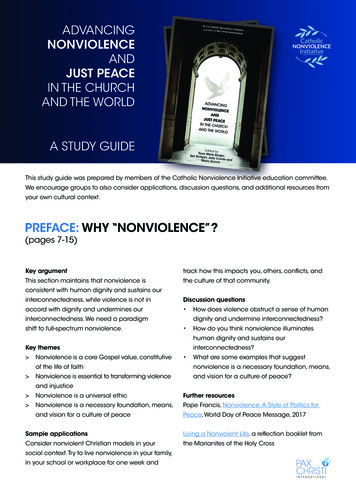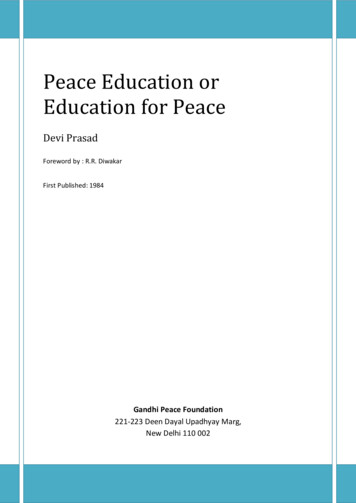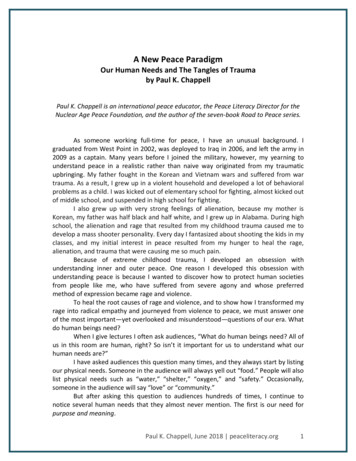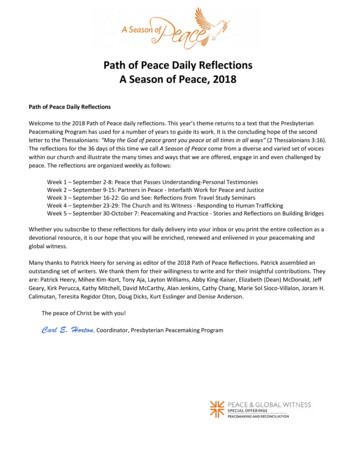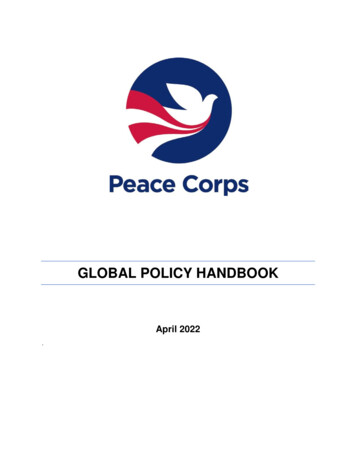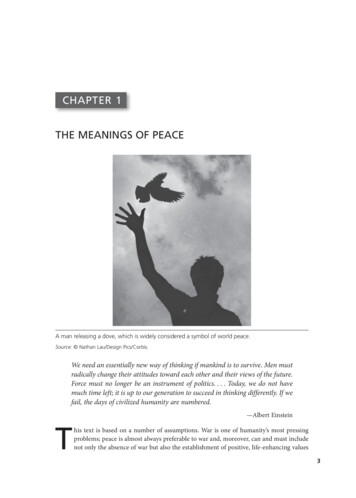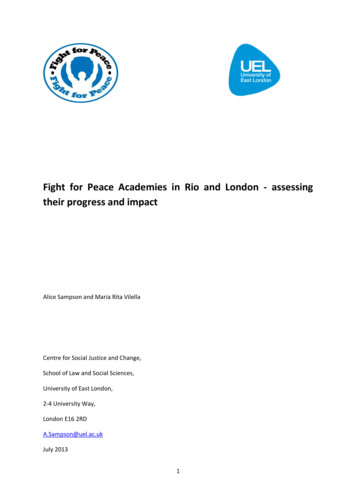
Transcription
Fight for Peace Academies in Rio and London - assessingtheir progress and impactAlice Sampson and Maria Rita VilellaCentre for Social Justice and Change,School of Law and Social Sciences,University of East London,2-4 University Way,London E16 2RDA.Sampson@uel.ac.ukJuly 20131
AuthorsAlice Sampson is Director of the Centre for Social Justice and Change (formerly Centre forInstitutional Studies, School of Law and Social Sciences, University of East London. Maria Rita Villelais a PhD Candidate at the Department of Social Sciences at the Pontifical Catholic University of Rio deJaneiro.AcknowledgementsWe would particularly like to thank all the young people who have participated in this research, thestaff at Fight for Peace (FFP/LPP), and partner organisations. Luke Dowdney, Marigold Ride, JulianTibau, Nina Wild, Shakeehla Baguus and Vinicius Riberio have all enabled the research to take place,have provided information, and made useful comments on draft reports. We really appreciate theirsupport.We would also like to thank FFP for funding this research and the Karl Popper Charitable Trust whofunded the time of Alice Sampson to develop the methods approach used in this study. We wouldlike to thank Maria Fofanah, research assistant, for her work on the datasets, and Ecorys forproviding additional data from their young people’s self-completion questionnaires.Alice Sampson & Maria Rita VillelaJuly 2013This report has been peer reviewed. It is one of the few studies to be included in the syntheses ofevaluated youth projects in London designed to reduce violent behaviour undertaken by Jyoti Belurand Nick Tilley, University College London, on behalf of the Project Oracle. This evaluation isincluded in two out of the three reviews; one on young people who are not in education,employment and training and the second on young people and sport.2
Contents1. Introduction2. Researching Fight for Peace2.1 Some challenges considered2.2 Research approach2.3 Research activities2.4 Assessing the findings3. About Fight for Peace4. Delivering the Fight for Peace model4.1 Robust implementation of FFP model4.2 Putting FFP values into practice4.3 The significance and role of an excellent reputation4.4 The monetary contribution of FFP to society555812121417171819205. Rio5.1 Complexo da Maré5.2 Violence and divisions5.2.1 Coercion and control by drug traffickers5.2.2 Killings by the police5.2.3 Violence at home5.2.4 Effects of violence on education5.2.5 Young people’s views about living in Maré5.3 State institutions: the care and protection of children and young people5.4 Luta Pela Paz5.4.1 Luta Pela Paz; the significance of an excellent reputation5.4.2 Some community effects of LPP; bridging the gap betweenworlds within and outside Maré5.4.3 Networking5.5 The Five Pillars model5.5.1 Attendance and attendees5.5.2 Personal development5.5.3 Boxing and martial arts5.5.4 Education5.5.5 Job training and work access5.5.6 Youth support services5.5.7 Youth leadership5.6 Key features of LPP21222222232324252525255.7 London5.8 London Borough of Newham262628303030313233343537383
5.9 Violence and division5.10 Young people’s experiences and views about living in Newham5.11 Fight for Peace: the significance of an excellent reputation6.4.1 Partners5.12 The Five Pillars model5.12.1 Attendees and attendance5.12.2 Personal development5.12.3 Boxing and martial arts5.12.4 Education5.12.5 Job training and work5.12.6 Youth support services5.12.7 Youth leadership5.13 Positive outcomes: progression with a pillar and inter-connectionsbetween the Five Pillars383942424343444445464748496. Assessing the Fight for Peace model6.1 Attracting young people6.2 Principles and practices of FFP model6.2.1 How do young people progress?6.2.2 Working with active members6.2.3 Disclosure of problems and/or desire to change life prospects6.2.4 Reassessment of self and situation6.2.5 Different self-perceptions and responses6.2.6 Different choices and alternative life courses6.3 What outcomes are less apparent or negative?6.3.1 Under what circumstances, and for whom, is FFP likelyto make less of a difference?6.3.2 Drug trafficking and ‘gangs’6.3.3 Does the FFP model cause harm?515152525354575971888890917. A concluding note on the role of boxing and martial arts andlife course of young people7.1 Introduction7.2 Core FFP theory of change7.3 Physical activity: changing body shape and feeling able to affect change7.4 Attributes and skills arising from training7.5 Skills arising from competitive settings7.6 Connections between learning ‘the discipline’ and everyday life7.7 SummaryAppendix A: Data collection10849494959697100103107
1. IntroductionThe purpose of the research conducted by the Centre for Institutional Studies, University of EastLondon between April 2012 and May 2013 is to independently assess the effect of the Fight forPeace (FFP) Academies on the lives of young people in London, UK, and Rio, Brazil. The research isalso designed to provide information to inform practice and development of FFP as an organisation.This report identifies factors which explain how FFP programmes impact upon the life course ofyoung people and summarises the main outcomes.A short report summarising the findings were published in November 2012 and can be found on theCentre’s website (www.uel.ac.uk/csjc)2. Researching Fight for Peace2.1 Some challenges consideredThere are a number of challenges evaluating multi-dimensional programmes like FFP which aremulti-causal and located in complex community settings.These challenges include:Using a reliable research design which addresses contribution; that is, finding out if a programmehas made a difference to the lives of young people, or if other factors account for the changes. Inshort, a robust evaluation finds out if the FFP programme is a cause that has an effect with theexpectation that many complex causal chains exist and contribute to an overall effect. Some will bedistinct logical chains, and others complex chains which are activated when they interact with otherlogic chainsAccording to many scientists attribution is most certain where an experimental design is used, andrandomised controlled trials (RCTs) are considered as the ‘gold standard’, a position not subscribedto in this study.1 For ethical reasons it is not feasible to allocate some young people, but not others,to a programme like FFP. Attendance at FFP is voluntary and creating a randomised control groupwould involve turning away some young people who would like to join and using them as a controlgroup, and comparing what happens to those in each group; the group selected to attend FFP andthe group of young people who have been turned away from FFP.Another possibility is constructing a control group using similar young people who did not volunteerto join FFP. This is also problematic because ‘being attracted’ to boxing and martial arts is a definingcharacteristic of FFP members. It would therefore only be a meaningful comparative group if youngpeople attending boxing and martial arts clubs are selected to be a control group, but this is not afair test because these young people are also receiving ‘treatment’.1See for example, Oakley, A. (2000), Experiments in knowing, Cambridge: Polity Press, who argues that RCTs best test theeffectiveness of interventions and policies. This study draws on the arguments made by Sampson (2007), ‘Developingrobust approaches to evaluating social programmes’, Evaluation, 13,3: 469-485, that finds out about how wellinterventions address the problems they are intended to address have been modified, and under which circumstances.5
Another challenge is understanding the complex relationships between participating in sport andexpected outcomes such as a reduction in criminality or attending education programmes andfinding work, and there is scant evidence that sport effects these outcomes. 2 Programmes such asFFP, affect intervening factors which are typically identified confidence and aspirations and it isthese changes which, in turn, influence a young person’s decision to start and complete aneducation course, or to stop committing violent crime, but intervening variables like self-esteemhave been found to have weak links to such outcomes.3 Thus, it has been found that increasedlevels of physical activity and its associated improvements in self-esteem are, at best, weakly relatedto improved educational attainment levels, and there is no discernible relationship between selfesteem and offending behaviour– offenders’ confidence can vary from very confident to low selfesteem.4 In a three year study no support was found for the hypothesis that engagement in physicalactivity deters criminality, and the authors questioned assumptions that the intervening variable –character building – actually happens through participation in sport.5There are also difficulties associated with measuring intervening variables. Improvements in selfesteem and confidence may happen in some social contexts but not others – young people may feelself-assured at home but lack confidence at school, or feel confident doing some activities at schoolbut not others. These concepts are also multi-faceted. Participating in sport may increase a youngperson’s confidence in their physical abilities or physical self-efficacy, but this does not necessarilymean that this improved confidence gives young people an increased desire to learn. 6Furthermore, commonly held assumptions that educational qualifications and finding work are theanswers to young people’s limited opportunities are not necessarily supported by research: paidwork does not necessarily lead to a reduction in offending, people without work stop offending orcontinue to offend whilst in employment; and, paid work is not necessarily a route out of povertyand disadvantage due to low wages.7Several commentators have noted that one of the paradoxes of sport is that it is the bastion ofprivilege and power, and it typically reinforces gender inequality, and therefore using sport fordevelopment in low income violence prone areas, is difficult to justify. 8 These researchers have also2See for example, Nichols, G. (2007), Sport and crime reduction, London: Routledge; Long, J., and Sanderson, I. (2001), ‘Thesocial benefits of sport: where’s the proof?’ in C. Gratton and I. Henry (eds) Sport in the city, London: Routledge, pages 187203. Smith, A., and Waddington, I. (2004), ‘Using ‘sport in the community scheme’ to tackle crime and drug use amongyoung people: some policy issues and problems’, European Physical Education Review, 10, 3: 279-298.3See for example, Bailey, R. (2005), ‘Evaluating the relationship between physical education, sport and social inclusion’,Educational review, 57,1: 71-90; Coalter, F. (2007), A wider social role for sport. London: Routledge.4Weak or no links have been identified by numerous researchers including, Elmer, N. (2001), Self-esteem: the costs andcauses of low self-worth, York: Joseph Rowntree Foundation; Nichols, G. (2007), Sport and crime reduction, London:Routledge; Coalter, F. (2007), A wider social role for sport. London: Routledge;5Begg , D., J. Langley, T. Moffitt, S. Marshall (1996), ‘Sport and delinquency: an examination of the deterrence hypothesisin a longitudinal study’, British Journal of Sports Medicine, 30: 335-341.6Coalter, F. (2007), A wider social role for sport. London: Routledge, page 99. Fox, K. (2000), ‘The effects of exercise on selfperceptions and self-esteem’ in eds. S. Biddle, K. Fox, S. Boutcher, Physical activity and psychological well-being. London:Routledge, pages 88-117.7Barry, M (2010), ‘Youth transitions: from offending to distance, Journal of Youth Studies,13,1: 121-136.8See for example, Dagkas, S. and K. Armour (eds) (2012), Inclusion and exclusion through sport. London: Routledge, pages124-155.6
questioned how participating in sport can reduce discrimination and oppression for girls and youngwomen by changing community norms.9Another challenge is that the academic literature on the practice of boxing and martial arts or ‘highbody contact sports’ has inconsistent findings and mixed opinions about whether or not they lead topositive moral and ethical development or facilitate aggression and violence.10 Some studies haveconcluded that high body contact sports enhance violence and criminality outside practice sessionsand account for a decline in moral values which are attributed to the culture of sport and a machoathletic subculture.11A rigorously designed research study was conducted in Norway with 477 boys aged 11 to 13 years. Ittook place over two years and found that participation in ‘power sports’ (boxing, wrestling,weightlifting, and oriental martial arts) led to an increase or enhancement of antisocial involvementoutside training sessions including, starting fights, use of weapons, vandalism and truancy. 12 Theseauthors concluded that the negative behaviours are likely to stem from the practice of power sportsitself and from ‘repeated contact with ‘macho’ attitudes, norms and ideals with a focus on musclesand physical strength and a belief in the value of toughness, and maybe violation of societalnorms’.13Other studies have favourable findings, and concluded that martial arts students have a greaterreduction in hostility than those participating in badminton and rugby. Military trainees who hadmartial arts training had higher improved feelings of self-control and lower scores for feelings ofvulnerability and likelihood of attack, than those who had completed physical fitness training.14These findings suggest that martial arts training can produce greater positive changes than otherphysical activities.However, the findings from these studies are unable to explain how participating in high contactbody sports makes either a negative or positive difference, or to explain the circumstances underwhich they have no apparent effect. How is it that some people learn aggression using high contactbody sports, whilst others learn self-control?This evaluation study has been designed with these challenges in mind.9See for example, Saavedra, M. (2009), ‘Dilemmas and opportunities in gender and sport-in-development’ in eds., P.Levermore and A. Beacom, Sport and international development. Basingstoke: Palgrave Macmillan. Pages 124-155.10Binder, B. (2007), ‘Psychosocial benefits of the martial arts: myth or reality? A literature review’, International RyukuKarate Research Society’s Journal.11The following studies are all quoted in Binder 2007 op. cite., and see Endressen, I.M., and Olweus, D. (2005),‘Participation in power sports and antisocial involvement in preadolescent and adolescent boys’, Journal of ChildPsychology and Psychiatry, 46,5:468-78.12Endressen, I.M., and Olweus, D. (2005), ‘Participation in power sports and antisocial involvement in preadolescent andadolescent boys’, Journal of Child Psychology and Psychiatry, 46,5: 468-78.13Endresen, I.M., and Olweus, D., 2005, op. cite., page 477.14Quoted in: Binder, B. (2007), ‘Psychosocial benefits of the martial arts: myth or reality? A Literature Review’,International Ryuku Karate Research Society’s Journal.7
2.2 Research approachTo take into account the issues discussed above, this study:Uses the academic literature to identify theories which best explain youth transitions, how amulti-dimensional intervention like FFP might work in principle to identify possible causallinks and contextual issues, and draws on information in discussions with staff, partners andyoung people to design the research.Uses brainstorming sessions and on-going meetings with staff and young people to identifyexpected causal links that explains how participating at FFP addresses problems and issues,and facilitates young people’s potential. This information is used to develop questionnairesand face-to-face interview schedules to test the theories that are embedded in theprogramme. These anticipated causal links are the hypotheses upon which the effectivenessof the programme rests. Where theories that underpin programmes are identified and‘tested’ then randomised control groups are not necessary.15Takes a problem-solving approach that ‘tests’ , and refutes, the theories that are embeddedin the FFP programme to ascertain if the problems the programme sets out to address havebeen modified. 16 Where data best fits particular hypotheses these are selected to explainhow the FFP programme works.17Identifies generative causal mechanisms that explain effects, and recognises that thesemechanisms are not always ‘active’, and that young people themselves, organisational ethosand management and community contexts affect causality. In other words, there is aninbuilt expectation that, at best, intervention programmes will positively affect some youngpeople in some situations and circumstances.18Claims of effectiveness are made where the experience of attending FFP can be identified asmaking a difference to its aims described in its mission statement: ‘working to overcomedivision and violence and promote the potential of young people in disadvantagedcommunities’. This statement informs two key questions for the research:1) Has the FFP model contributed to overcoming division and violence?2) Has the FFP model promoted the potential of young people?This study:Measures the impacts for young people during their time at FFP, and for those whoattended intensive programmes up to six months after they attended their first programme,and some data on desistance from offending from 2010.Recognises that the FFP model is specifically designed to work with young people in areasprone to violence and crimes referred to in this report are typically inter-personal violent15Weiss, C. (1997), How can theory-based evaluation make greater headway?’, Evaluation Review,21,4:501-24.Popper, K. (1968), The logic of scientific discovery, 2nd edn. London: Hutchinson.17Sampson, A. (2007),‘Developing robust approaches to evaluating social programmes’, Evaluation, 13,3: 469-485.18For a realistic approach to evaluation and its appropriateness for evaluating community sports programmes see, Pawson,R. and Tilley. N. (1997), Realistic evaluation. London: Sage; Tacon, R. (2007), ‘Football and social inclusion: evaluating socialpolicy’, Managing Leisure, 12: 1-23.168
crime, including sexual exploitation and drug trafficking.19 Young people may be deterredfrom committing property offences but the mechanisms that may account for desistance arenot fully explored in this study.2.2.1 Generating robust and useful evidenceOur research is also designed to contribute to the development of FFP as an organisation and its FivePillars model. To achieve this intention two aspects of FFP are particularly pertinent.Firstly, FFP is an organisation that operates in more than one place. It retains its core values, FivePillar principles and ethos on the one hand, and on the other, the FFP model is sensitive to localcommunity and cultural settings and to shortcomings in the delivery of services by state agencies,and adapts its programmes accordingly. For example, an education pathways programme is run for12 weeks in London and in Rio the course lasts for a year, and in Rio a lawyer and psychologistattend LPP every week, but there are no such formal arrangements in London.Secondly, FFP places monitoring and evaluation at the heart of its organisation and uses theinformation to reflect upon their performance and to discuss how they can improve theirprogramme. The research includes finding out about how the FFP programme works in differentsettings, and learning across sites – promoted by regular visits by staff between the Academies andregular Skpe meetings, actively encouraged by the founder, Luke Dowdney, and, as a result, themonitoring and evaluation systems in London and Rio are similar.It is in this context that a ‘robust’ evaluation includes generating evidence that is relevant and usefulto the organisational practices of FFP and its goals, as well as assessments of effectiveness.20Features of a robust evaluation study of FFP include:Incorporating critical factors for ‘success’ into the research by ‘testing’ key assumptions thatinform how the FFP programme works; for example, that boxing and martial arts attractyoung people and are a ‘hook’ to engage with the most marginalised and disaffected as wellas those who lack opportunities to fulfil their potential, and that FFP is a safe place whereyoung people are valued and respected.Collecting data to incorporate an institutional analysis into the research by recognising thatprogrammes are delivered by organisations, and that institutional arrangements impactupon the implementation of programmes and their effectiveness.21 Thus, simply gathering19The term drug trafficking is used in this report instead of drug dealing, as frequently used in the UK, because the dealingof marijuana, cocaine, and crack cocaine is part of everyday living in Rio project, and the term drug trafficking is used inBrazil.20What counts as relevant evidence in this study is described in this section, and earlier in this chapter, using a broaddefinition. However, what type of evidence is able to reliably demonstrate that a social policy will be effective in more thanone location is the subject of much debate with contested notions about how best to conceptualise and measure causalityand what counts as relevant and reliable evidence when informing the development of policies, programmes and practices(see for example, Cartwright, N. and Hardie, J. (2012), Evidence-based policy: a practical guide to doing it better’, Oxford:Oxford University Press. Nutley, S., Powell, A. and Davies, H. (2012), What counts as good evidence? Provocation Paper forthe Alliance for Useful Evidence, London, November).21Popper drew attention to how organisations are shaped by people and decisions are made from an organisationalperspective. He observed: ‘Institutions do not act; rather, only individuals act, within or on behalf of institutions.’ Popper,K. (1992 [1969]), In Search of a Better World: Lectures and Essays from Thirty Years, London: Routledge, page 80. Thus,organisations are both social contexts and mechanisms that explain changes in the lives of young people .9
data on activities that are linked to specified outcomes, for example training in writing CVs,and interviewing skills for employment to increase the opportunities for young people toobtain work, does not sufficiently explain how outcomes are achieved. Organisationalethos, goals, and staff commitment and confidence in working effectively with young peopleare all integral to finding out ‘what works’, ‘how’, and with what effect.Judgements about effectiveness are made by drawing on information from several sourceswithin the context of the programme. These judgments include considering what is realisticto achieve in the circumstances, the amount of resources and effort invested in a particularactivity, and assessing changes or levels of improvement that matter from a causalperspective. For example, in 2009 in the London Borough of Newham, 87% of the youngpeople who completed a questionnaire said that they felt fitter as a result of participating inboxing and martial arts training. Although this finding indicates that the training wassuccessful for the overwhelming majority, staff decided to work towards improving thisstatistic. They renewed their efforts by ensuring that coaches were training to a professionalstandard by replacing a coach and by introducing a ‘Fighting Fit’ programme for the gym, asrequested by young people. By 2011, 95% of the young people who completed aquestionnaire said that they felt fitter, an 8% improvement. Face-to-face interviews withyoung people found that ‘feeling fitter’ contributes to other positive improvements such asfeeling calmer – rising from 74% to 77% and feeling better about themselves, rising from60% to 87%, for example.22Generating knowledge that contributes to the problem-solving skills of staff. This can beachieved by working collaboratively with staff in designing the research, and giving themopportunities to analyse and discuss findings. This approach recognises that implementing aprogramme is a self-perpetuating cycle of problem-solving and staff routinely encounternew challenges as economic conditions change, new policies alter the behaviour of stateagencies, and young people find new forms of excitement which can be illegal. The diagrambelow illustrates how this process of self-perpetuating problem-solving occurs:22Statistical significance testing is not used in this study. Whilst this mathematical technique may be relevant in a closedsystem this is different from significance in a real world setting where things are significant only when we choose to labelsomething as such. In complex social structures there are no limits to the causal chains that link interacting open systemsand for evaluations relevant knowledge is about what causal links exist and under what circumstances, and how they maybe strengthened and/or activated by policies and interventions. In real world situations it is therefore not clear why amathematical significance test should be accorded a privileged position in assessing success (see Burgess, T. (1994),‘Towards a social science: a comment on Karl Popper’s ‘twenty seven theses’. In eds., Pratt, J., Locke, M., and Burgess, T,Readings in Institutional Studies, Book 1: Popper and problems, problems with Popper, Working Paper 64, Centre forInstitutional Studies, University of East London, pages 55-66).10
Figure 2.1: Implementing programmes: a self-perpetuating cycle of problem solvingFFP values &Five Pillarmodelprinciplesimplementednew problemsarise & arecharacterisedby stafffrom thisproblemformulationhypothesesabout how tomeet thesechallenges aredevisedActions aretaken, newproblemsarise, problemformulationsare adaptedfurther actionsare taken &the processrenews itselfFrom this perspective useful evaluations are those which enable staff to understand, articulate andassess their practices and therefore contribute to developing the organisation, as an institution,including practice. Research questionnaires and interview schedules are developed and adapted toreflect the working hypotheses that staff articulate, what actually happens in practice, and measurefactors or mechanisms that account for outcomes. Since 2009 staff at FFP have reviewed annual selfcompletion questionnaires and whilst a core set of questions remain, others have been adapted toreflect emerging issues and improved understandings of how change occurs. Similarly, youth councilmembers have been involved in designing the research.Examples of the interactions between practice and research include the following: staff identifiedthat changes in young people’s position from ‘self-hatred/dislike’ to self-acceptance is a key factorthat explains changes in attitudes, thinking, and behaviour. Through discussions over the last twoyears an increasing number of factors have been identified that contributing to these concepts. In2009 questions related to self-acceptance included ‘feeling better about myself’ and ‘feeling calmer’,and, subsequently, new sessions on gender and sexual identity were incorporated into personaldevelopment classes, and a question was added to the self-completion questionnaires about howyoung people feel about themselves as a young woman or a young man, because acceptance ofgender and sexuality were identified as component parts of self-acceptance.This reflective and adaptive practice with the involvement of staff and young people gives addedconfidence that the research design is robust; that is, it is more likely to identify and ‘test’ evolvingcausal relationships that arise from improved problem identification and problem-solving, and givesmore certainty that the data are reliably measuring what is happening. One example of this processis from Rio; a few young people began questioning and challenging the ‘front lines’ marked out bythe drug factions and in 2012 a question was added to the self-completion questionnaire to test thishypothesis: ‘Do you feel safer visiting other communities since you began attending Luta Pela Paz?’and it was found to be a more general pattern of change. Thus, an additional effect or outcome ofFFP was identified and incorporated into the research.A further indicator of robustness is the use of the research findings by staff. If staff trust researchfindings and they are relevant to their everyday work then they will use them to identify problemsand opportunities, and to develop stronger theories or working hypotheses that better predict howto work effectively. Thus, research findings contribute to FFP continuously and actively shaping itsown life course. 2323Like many organisations FFP also uses findings from research for staff inductions and training, as evidence to fundersthat they are meeting their targets, and in the preparation of applications for further funds. The requirements of fundersand pressures to use ‘off-the-shelf’ questionnaires tends to sideline monitoring and evaluation into administrative tasks11
2.3 Research activitiesThe following outlines the information sources upon which the research in Rio and London drew:The research activities included:Review of the academic literature on youth transitions, the effects of sports, youth work,education and employment, and personal development on the lives of young people, andevaluationsMonitoring data from FFP/LPP AcademiesYoung people’s self-completion questionnaires (London 2011; Open Access n 118; Intensivegroup (pathways and twilight programmes) n 70: Rio 2012; Open Access n 86; Intensivenew pathways education programme n 83)Youth Council self-completion questionnaires (Rio n 11; London n 11)Staff self-completion questionnaires (Rio n 37; London n 16)Face-to-face interviews with young people (21 in Rio and 37 in London)Fac
5.5 The Five Pillars model 28 5.5.1 Attendance and attendees 30 5.5.2 Personal development 30 5.5.3 Boxing and martial arts 30 . education course, or to stop committing violent crime, but intervening variables like self-esteem have been found to have weak links to such outcomes.3 Thus, it has been found that increased

